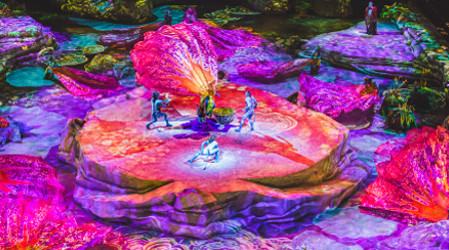Cirque’s Avatar-Inspired ‘TORUK’ Captured in 4K
In its quest to capture the magic and imagination of James Cameron’s move “Avatar,” Cirque du Soleil’s new show “TORUK: The First Flight” combines live-action projected video scenery across a multi-level arena-sized stage, incredibly detailed makeup and costumes that transform Cirque du Soleil’s performers into the blue-skinned Na’vi, and large-scale puppetry that includes a gigantic Pterodactyl-style human-rideable Toruk bird of prey that flies! Add the incomparable skills of Cirque du Soleil’s acrobats, gymnasts, and other athletes plus a fabulous light show/soundtrack—all approved and influenced by Cameron himself— and you have a stage spectacular worthy of broadcasting and preserving for all time in 4K video.

For the Montreal shoot, which took place over three days, Wills and Benning used up to eight F55s. One was mounted high above the action in the lighting grids, while these two more were mounted on each side of the stage, running on Junior remotely-controlled camera dollies (on tracks).
Although TORUK is just starting many years of world touring, Cirque du Soleil has already taken this step. Specifically, the Montreal-based troupe hired Director Adrian Wills and Director of Photography Jeremy Benning to shoot the show last December when it opened at Montreal’s Bell Centre arena. Both men had already worked Cirque du Soleil on a “making of” documentary about TORUK.
“Our goal in shooting TORUK was not just to do a live-to-tape capture of a stage show,” Wills told Broadcast Engineering Extra. “Instead, we shot lots of on-stage closeups without an audience later in Quebec City, so that we could turn TORUK into a true narrative feature film; much in the style of Avatar itself.” (As someone who has seen both the impressive stage show and the TV version, this writer can affirm that Adrian Wills’ TORUK video achieves his lofty goal.)
4K A REQUIREMENT
When Cirque du Soleil decided to capture TORUK in video last year, the company had no doubt that 4K was the way to go. “The video production industry globally is producing a lot of content in 4K,” said Sebastien Ouimet, Cirque du Soleil’s senior advisor on media content & distribution and the 4K show’s producer. “Broadcasters are getting ready to broadcast content in 4K, especially in key markets such as China. [In addition] we wanted to make sure that any content we produce is thus in 4K, so that it can be broadcast for the next 10-15 years.”
As well, the resolution offered by 4K compared to 1080p was more appropriate for a show being produced to the standards of a feature film. It also made the 4K project appealing to Bell, operator of the Canadian Fibe IPTV service, which financed the production.
The professional video industry's #1 source for news, trends and product and tech information. Sign up below.
F55 OR NOTHING
For Cirque du Soleil, choosing the right 4K camera to shoot TORUK was a no-brainer. “The broadcasters we are working were insistent that we use the Sony PMWF55 CineAlta 4K camcorder,” said Benning. “They told us that the F55 was the 4K camera that countries like Japan wanted, due to it offering the most pixels and what they called ‘the truest 4K picture quality.’”
For the Montreal shoot, which took place over three days, Wills and Benning used up to eight F55s. One was mounted high above the action in the lighting grids, while two more were mounted on each side of the stage, running on Junior remotely-controlled camera dollies (on tracks). “We also had F55s on JimmyJibs and telescoping arm Techno-Jibs, plus tripods around the arena,” said Benning.
“Because we knew the show so well from doing the ‘making of’ documentary, we had a very good idea of what kinds of shots we needed,” said Wills. “We also moved our cameras every night, to maximize the angles and variety of shots we had to work with in post-production.”

The cast and crew of TORUK
To create a true film experience, Wills and Benning needed to capture a number of closeups that could be cut into the wide and medium shots. “Getting up on the stage with cameras during an actual show was out of the question,” Wills said. “So what we did was to shoot two days’ worth of closeups during the show’s off-time in Quebec City, on stage without the audience.” Benning did this using two Steadicams; one on each side of the character being captured on video. The shots were just sections of various scenes that Wills had the actors perform as needed, rather than doing the entire show.
All of the video was saved directly to AXSM memory cards in F55’s AXS-R5 bolt-on recorder. “We show in the RAW video 4K format for the highest possible resolution,” said Benning. “Although we did take feeds from the cameras via fiber-optic cable to a mobile production truck where Adrian and I could watch and call shots, and save a backup in HD, the RAW video cards were the resource for saving 4K footage.”
A TRIP BACK TO THE OLD DAYS
Once Wills’ crew had finished the 4K shoot in Quebec City, the AXSM video cards were turned over to QuébéComm, a production company that has produced shows for Celine Dion and Madonna in the past. “We were chosen by Cirque Du Soleil as line producers for our expertise and vision in order to put the whole production together; including giving them access to our post production facility based in Montréal,” said Marie-Claude Filteau, the QuébéComm line producer who worked on TORUK. “We worked hand in hand with Cirque du Soleil on every step of the production.”
This was no small task: Working with TORUK’s 40TB of 4K footage required the purchase of two Promise Pegasus 48TB hard drives formatted in RAID 5 and three G-RAID disks of 16TB each. “Meanwhile, since we only had five weeks to turn the production around, we didn’t have the time to buy 4K production equipment,” Filteau said. “So editing TORUK in 4K was like the early days of HD, where we would edit in SD and then computer-generate create a high-resolution HD version using the SD edit list.” QuébéComm offline edited the HD version using Avid v8.4.5 in DNX36, and then conformed the final version in 4K; a task that required 30 hours of machine time.
Editing wasn’t the only challenge the TORUK 4K crew faced. “Since we were shooting a stage show, there were times where we had to have the lighting director tone down the spotlights on the main characters,” said Benning. “If we didn’t, the Na’vi’s trademark blue skin looked grey on screen.”
Too much resolution was also an issue, given that 4K’s precision showed the seams between costumes and made-up faces. “In post, we went through the closeup shots carefully; rejecting those that gave away too much detail,” said Wills.
Teething pains aside, Cirque du Soleil’s 4K production of TORUK was a success; one that won the all-important approval of James Cameron and staff at his Lightstorm Entertainment company. “We are so happy with how well 4K worked for us, that all of our future productions will be shot in 4K,” said Ouimet. “Compared to 3D, it was pretty easy working in 4K,” added Benning. “Meanwhile, the visual quality speaks for itself.”
James Careless is an award-winning journalist who has written for TV Technology since the 1990s. He has covered HDTV from the days of the six competing HDTV formats that led to the 1993 Grand Alliance, and onwards through ATSC 3.0 and OTT. He also writes for Radio World, along with other publications in aerospace, defense, public safety, streaming media, plus the amusement park industry for something different.

